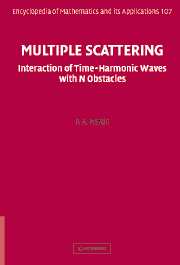Crossref Citations
This Book has been
cited by the following publications. This list is generated based on data provided by Crossref.
Li, Yile
and
Mei, Chiang C.
2007.
Multiple resonant scattering of water waves by a two-dimensional array of vertical cylinders: Linear aspects.
Physical Review E,
Vol. 76,
Issue. 1,
Hou, Bo
Mei, Jun
Ke, Manzhu
Wen, Weijia
Liu, Zhengyou
Shi, Jing
and
Sheng, Ping
2007.
Tuning Fabry-Perot resonances via diffraction evanescent waves.
Physical Review B,
Vol. 76,
Issue. 5,
LI, YILE
and
MEI, CHIANG C.
2007.
Bragg scattering by a line array of small cylinders in a waveguide. Part 1. Linear aspects.
Journal of Fluid Mechanics,
Vol. 583,
Issue. ,
p.
161.
Antoine, Xavier
Chniti, Chokri
and
Ramdani, Karim
2008.
On the numerical approximation of high-frequency acoustic multiple scattering problems by circular cylinders.
Journal of Computational Physics,
Vol. 227,
Issue. 3,
p.
1754.
Mishchenko, Michael I.
2008.
Multiple scattering, radiative transfer, and weak localization in discrete random media: Unified microphysical approach.
Reviews of Geophysics,
Vol. 46,
Issue. 2,
Wright, Derek W.
Cobbold, Richard S. C.
and
Yu, Alfred C. H.
2008.
Ultrasound wave propagation in time-varying phononic crystals.
p.
1491.
Hu, Zhen
and
Lu, Ya Yan
2008.
Improved Dirichlet-to-Neumann map method for modeling extended photonic crystal devices.
Optical and Quantum Electronics,
Vol. 40,
Issue. 11-12,
p.
921.
Wright, D W
and
Cobbold, R S C
2009.
Acoustic wave transmission in time-varying phononic crystals.
Smart Materials and Structures,
Vol. 18,
Issue. 1,
p.
015008.
Krynkin, A.
and
McIver, P.
2009.
Approximations to wave propagation through a lattice of Dirichlet scatterers.
Waves in Random and Complex Media,
Vol. 19,
Issue. 2,
p.
347.
Ganesh, M.
and
Hawkins, S. C.
2009.
A high-order algorithm for multiple electromagnetic scattering in three dimensions.
Numerical Algorithms,
Vol. 50,
Issue. 4,
p.
469.
Pashaev, Oktay K.
and
Yilmaz, Oguz
2009.
Power-series solution for the two-dimensional inviscid flow with a vortex and multiple cylinders.
Journal of Engineering Mathematics,
Vol. 65,
Issue. 2,
p.
157.
Kononov, V.G.
and
Balanis, C.A.
2009.
Multipath scattering by cylinders and spheres.
p.
1.
Caleap, Mihai
Aristégui, Christophe
and
Angel, Yves C.
2009.
Effect of crack opening and orientation on dispersion and attenuation of antiplane coherent wave.
Geophysical Journal International,
Vol. 177,
Issue. 3,
p.
1151.
Klein, Georg
2010.
Industrial Color Physics.
Vol. 154,
Issue. ,
p.
295.
Kononov, Victor G.
and
Balanis, Constantine A.
2010.
Analysis and Simulation of the Propagation Channel Complexity on Signal Fading.
IEEE Antennas and Wireless Propagation Letters,
Vol. 9,
Issue. ,
p.
895.
Conoir, Jean-Marc
and
Norris, Andrew N.
2010.
Effective wavenumbers and reflection coefficients for an elastic medium containing random configurations of cylindrical scatterers.
Wave Motion,
Vol. 47,
Issue. 3,
p.
183.
Menshykova, Maryna V.
Menshykov, Oleksandr V.
and
Guz, Igor A.
2010.
Modelling Crack Closure for an Interface Crack Under Harmonic Loading.
International Journal of Fracture,
Vol. 165,
Issue. 1,
p.
127.
Martin, P. A.
and
Maurel, A.
2010.
Waves around almost periodic arrangements of scatterers: Analysis of positional disorder.
Mathematical Methods in the Applied Sciences,
Vol. 33,
Issue. 18,
p.
2215.
Parnell, William J.
and
Abrahams, I. David
2010.
Multiple point scattering to determine the effective wavenumber and effective material properties of an inhomogeneous slab.
Waves in Random and Complex Media,
Vol. 20,
Issue. 4,
p.
678.
Wright, D W
and
Cobbold, R S C
2010.
Two-dimensional phononic crystals with time-varying properties: a multiple scattering analysis.
Smart Materials and Structures,
Vol. 19,
Issue. 4,
p.
045006.



